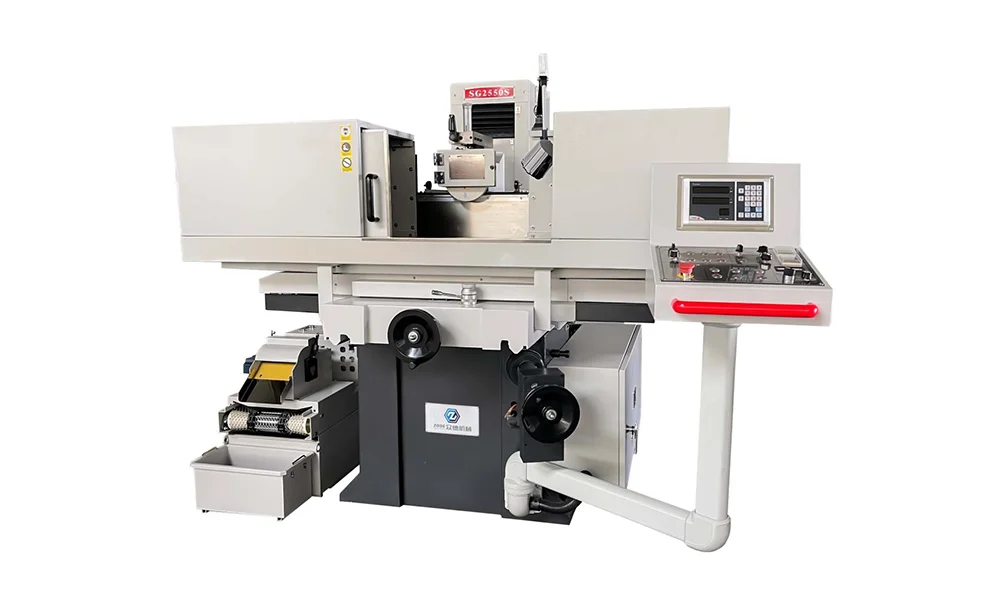- This topic is empty.
-
AuthorPosts
-
2025-08-20 at 6:38 pm #7346
In the modern manufacturing industry, surface quality is not merely a matter of appearance—it is a critical factor influencing product functionality, durability, and performance. Achieving ultra-flat, smooth surfaces requires equipment capable of combining mechanical accuracy with operational efficiency. Among the specialized tools in precision machining, the single axis surface grinding machine stands out as a streamlined yet highly effective solution for certain applications. While multi-axis machines dominate complex profiles, single-axis grinders excel in delivering consistent, repeatable surface finishes for planar workpieces. In this blog post, Nantong Zode, a professional industrial grinding machine equipment manufacturer, will share the role of single axis surface grinding machine in modern manufacturing.
Understanding the Single Axis Surface Grinding Machine
A single axis surface grinding machine is designed to move either the grinding wheel or the workpiece along a single linear direction—typically the X-axis or Y-axis—while maintaining precise vertical control over the grinding depth. The restricted motion path simplifies control systems and reduces mechanical complexity, resulting in higher stability and cost-effectiveness for flat surface processing.
Key components generally include:
-
Base and Table: Providing structural stability and workpiece positioning.
-
Grinding Wheel Assembly: Powered by a high-precision spindle for consistent rotation speed.
-
Guideways: Ensuring linear, backlash-free movement along the designated axis.
-
Control Panel: Allowing operators to set feed rate, grinding depth, and cycle duration.
Why Choose a Single Axis Configuration?
Although multi-axis systems have greater flexibility, single-axis surface grinders offer unique benefits for specific production environments.
-
High Stability for Flat Grinding – The reduced degrees of freedom minimize vibration and geometric errors, leading to superior flatness and parallelism.
-
Simplified Maintenance – Fewer moving parts translate into lower wear rates, reduced maintenance costs, and longer service life.
-
Optimized for Batch Processing – Ideal for high-volume production of uniform components such as plates, shims, and mold bases.
-
Lower Investment Cost – Single-axis machines often have a smaller footprint and lower purchase price compared to complex CNC systems.

Applications Across Industries
The single axis surface grinding machine is used in a variety of manufacturing fields where precision and repeatability are paramount.
-
Tool and Die Manufacturing: Ensuring mold components have perfectly flat mating surfaces.
-
Automotive Industry: Producing gaskets, spacers, and clutch plates with consistent thickness.
-
Electronics and Semiconductors: Preparing heat sinks and circuit substrates for optimal thermal conductivity.
-
Metalworking Shops: Refining steel plates and non-ferrous metal parts to tight tolerances.
Its application versatility makes it a reliable asset in both high-precision workshops and high-volume production lines.
Technical Considerations for Optimal Performance
1. Grinding Wheel Selection
Choosing the correct wheel material (aluminum oxide, silicon carbide, CBN, or diamond) ensures optimal cutting efficiency and surface finish quality.
2. Feed Rate and Depth of Cut
An optimal balance between feed rate and grinding depth minimizes heat generation, prevents workpiece warping, and extends wheel life.
3. Coolant and Lubrication
Using the right coolant type and delivery system reduces thermal distortion, flushes away swarf, and maintains consistent surface quality.
4. Machine Alignment
Regular inspection and calibration of the guideways and spindle ensure long-term accuracy and avoid uneven wear patterns.
The Role of Automation and Digital Control
Although traditionally manual or semi-automatic, modern single axis surface grinding machines are increasingly equipped with programmable digital controls. These enhancements offer:
-
Preset Depth Control: Automatically halts grinding at the exact target dimension.
-
Cycle Repetition: Improves efficiency in repetitive batch operations.
-
Data Logging: Records feed rates, cycle times, and dimensional results for quality assurance.
This integration bridges the gap between simplicity and smart manufacturing, enabling small workshops to meet Industry 4.0 requirements without overcomplicating operations.
Comparing Single Axis to Multi-Axis Grinding Machines
Single Axis Advantages:
-
Superior flatness for planar surfaces
-
Lower initial and operational costs
-
Easier training for operators
-
Reduced mechanical wear
Multi-Axis Advantages:
-
Capability for complex contours and profiles
-
Greater versatility in handling diverse workpieces
-
Suitable for specialized 3D surface grinding tasks
In essence, the decision between single and multi-axis grinding depends on whether the manufacturing priority is specialized high-volume flat work or versatile multi-geometry machining.
Maintenance Best Practices
To ensure consistent performance and extend service life, operators should follow these maintenance routines:
-
Daily Cleaning: Remove swarf and debris from table surfaces and wheel guards.
-
Wheel Dressing: Regularly dress the wheel to maintain sharp cutting edges and prevent glazing.
-
Lubrication: Apply proper lubrication to guideways and spindle bearings as recommended by the manufacturer.
-
Alignment Checks: Perform periodic calibration to maintain geometric accuracy.
-
Coolant Management: Replace or filter coolant to prevent contamination and bacterial growth.
Environmental and Safety Considerations
Operating a grinding machine involves high-speed abrasive contact, which demands strict adherence to safety protocols.
-
Protective Guards: Must always be in place to shield operators from sparks and debris.
-
PPE: Safety glasses, gloves, and hearing protection are mandatory.
-
Dust Collection Systems: Reduce airborne particles, especially when grinding non-ferrous metals.
-
Coolant Recycling: Minimizes environmental impact and operational costs.
Conclusion
The single axis surface grinding machine represents a focused, dependable, and cost-effective approach to achieving flat, precise surfaces in manufacturing. Its strength lies in its stability, repeatability, and straightforward operation, making it a trusted choice for industries where uniformity and surface perfection are non-negotiable. While it may not replace multi-axis solutions for complex geometries, it excels in its specialized domain—proving that in precision engineering, sometimes less movement means more accuracy.
http://www.zodemc.com
Nantong Zode -
-
AuthorPosts
- You must be logged in to reply to this topic.
